TechRadar Verdict
The Garmin Vivosmart 5 is a lightweight, lean fitness tracker for anyone who values data above looks. It's not as chic as a Fitbit Luxe or Inspire 2, but packs a whole lot more info and insights at your fingertips, with even more available in the Garmin Connect mobile app (with no subscription fee). The lack of on-board GPS is a shame, but for keeping tabs on your everyday wellbeing and recovery stats, it's excellent.
Pros
- +
Well designed interface
- +
Extremely light and comfortable
- +
Auto activity tracking
- +
Particularly good sleep tracking
Cons
- -
Monochrome display
- -
No on-board GPS
- -
Polycarbonate lens rather than toughened glass
Why you can trust TechRadar
Editor's Note
January 2024
The Garmin Vivosmart 5 was reviewed in October 2022, and the Vivosmart range hasn't been updated since then. However, it's still the cheapest tracker in Garmin's stable, and band-based fitness trackers haven't moved forward all that much as a category since its release. For our money, it's still a good buy for budding runners, cyclists, and generally active people especially as it can be found quite cheaply now. It provides access to the very sophisticated Garmin Connect app, which can help you comprehensively plan your training and recovery for specific events.
The rest of this review remains as previously published.
Two-minute review
The Garmin Vivosmart 5 is a lightweight fitness tracker that takes the fight directly to Fitbit – and fares well. It's certainly not as attractive as devices like the Fitbit Charge 5 and Fitbit Luxe thanks to its rather utilitarian design and monochrome screen, but it's practical and puts a huge amount of data right at your fingertips.
Size: 19.5 x 10.7 x 217mm (small), 19.5 x 10.7 x 255mm (large)
Weight with strap: 24.5g (small), 26.5g (large)
Display type: grayscale OLED
GPS: No
Sports modes: 14 total, 10 available on watch at a time
Operating system: Garmin Watch OS
The most obvious upgrade from the Vivosmart 4 is the larger, higher resolution screen. Garmin makes good use of all that extra space to cram in an impressive array of data – including graphs and charts to show trends, which is something you don't get on many fitness trackers this size. Despite the lack of color to differentiate different pieces of data, it's all clear and easy to interpret at a glance.
Unlike the Fitbit Charge 5, the Vivosmart 5 lacks on-board GPS, meaning it's dependent on a Bluetooth connection to your phone for monitoring your route and pace during outdoor activities. It can also use its on-board accelerometer to estimate distance and pace, but it's only a rough guide and shouldn't be relied upon if you're training for an event.
While some of Fitbit's best features (including advanced sleep and stress insights) are only available if you have a Fitbit Premium subscription, all of Garmin's data and stats are yours to browse free of charge in the excellent Garmin Connect app. You'll also find a selection of guided workouts to follow, plus adaptive training plans for cycling and running. You won't get the vast library of videos that you do with Fitbit's premium service, but Garmin doesn't lock anything behind a paywall.
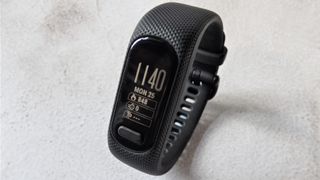
The Vivosmart 5 isn't quite as beginner-friendly as an entry-level Fitbit, putting statistics front and center, but if you're a bit of a data nerd then that approach will definitely appeal.
The Vivosmart 5 could also be a smart choice if you already own a full-fat Garmin sports watch but find it cumbersome for everyday wear in between training sessions. The Garmin Connect app supports multiple devices, and all your data is pooled together, regardless of which watch you were wearing.
Price and release date
- Released April 2022
- Cost $149.99 / £129.99 / AU$229 at launch
The Garmin Vivosmart 5 was released on 20 April, 2022 – four years after the Vivosmart 4 – with a recommended retail price of $149.99 / £129.99 / AU$229.
That's a standard price for a higher-end fitness tracker, but if you're starting to get serious about running and are looking for a watch with GPS that'll give you guidance on your training, you can currently pick up the excellent Garmin Forerunner 55 for only a little more.

Battery life
- Seven days in smartwatch mode
- Four days with all sensors and sleep tracking enabled
The Vivosmart 5 offers the same battery life as the Vivosmart 4. Garmin quotes a maximum runtime of seven days in smartwatch mode, but enabling SpO2 monitoring will cut that significantly. In our tests, the watch lasted four days and nights with 24-hour SpO2 monitoring enabled, and tracking one workout per day. We were able to recharge the battery from flat in a little over two hours.
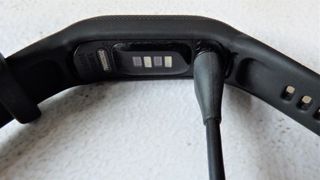
Design and display
- Larger display than Vivosmart 4
- Available in two sizes
- New physical button on face
First of all, it's worth noting that the Garmin Vivosmart 5 comes in two sizes: small/medium (for wrists with a circumference between 122mm and 188mm), and large (for wrists with a circumference between 148mm and 228mm).
At first glance, both versions look very similar to the Vivosmart 4. The tracker itself has a slim build, and sits in a soft silicone band/case. This time around though, the band is replaceable; just bend the band back a little to pop the tracking unit out, then push it into the new strap – no tools necessary.
The Vivomove 5 lacks the aluminum bezel of its predecessor – a decision that makes it look a little less stylish, but almost certainly helped Garmin's designers save a few precious grams. The small/medium version we tested is just 24.5g including its band, while the large model is 26.5g, making it seriously lightweight.

Garmin has also swapped the capacitive button at the bottom of the watch's face for a physical one. This might seem like a strange choice as it interrupts the device's sleek lines, but it's a decision we welcome because it makes the Vivosmart 5 much easier to operate when you're wearing gloves, or have wet hands (the device is water resistant for swimming, though not for diving or fast watersports).
On the reverse, you'll find the optical heart rate and SpO2 sensors, plus the charging socket. The Vivosmart 5 uses the same proprietary charging cable as all other Garmin devices used in recent years, and it plugs in securely.
Perhaps the most obvious difference between the Vivosmart 5 and its predecessor is its new, larger OLED screen. The Vivosmart 5 has a higher resolution display than its predecessor, but it's still monochrome rather than color. This makes it less striking than the Fitbit Luxe, but Garmin's designers have used the limited space and palette in a smart way, conveying an impressive amount of of data on each screen. Rather than being cut off (as was sometimes the case with the Vivosmart 4), longer snippets of text scroll, and you can see at least three stats on screen at any one time.
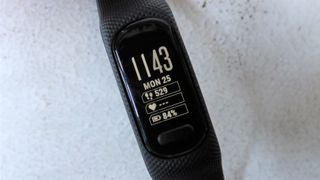
The Vivosmart 5 also has an ambient light sensor, which adjusts the brightness of the screen dynamically to suit the current conditions. We found it worked well, but it's also possible to pick a brightness level manually, adjust the timeout period before the screen goes to sleep, or even choose always-on mode (though all of these will have an impact on battery life).
Everyday health tracking
- Excellent sleep tracking
- SpO2 monitoring drains battery rapidly
- All-day stress monitoring works well
The Vivosmart 5 monitors sleep automatically, and in our tests it accurately detected when we fell asleep and woke – and its sleep stage tracking largely aligned with that recorded by our Withings Sleep Analyzer. Each morning you'll be presented with a mini report, including a sleep score (based on your sleep duration and time spent in each stage), a tiny weather forecast for the day ahead, and a quick overview of your upcoming calendar eventes. You can explore your sleep data in more detail using the Garmin Connect app.
The only downside is that Garmin's sleep tracking doesn't account for naps, and if you grab 40 winks in the evening, it can throw out your nightly data. Naps are something Amazfit devices track well, and we've got our fingers crossed that Garmin will update its sleep and recovery algorithms to accommodate them soon.
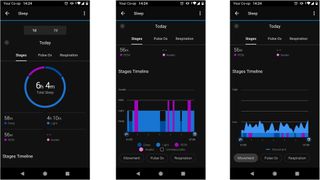
You can also choose to enable SpO2 monitoring overnight, or 24 hours a day, but as mentioned earlier, this has a huge impact on battery life. Unless you're particularly concerned about oxygen saturation (if you suspect you may suffer from sleep apnea, or are training at altitude for example), leaving it off may be a sensible compromise.
Garmin combines data from your sleep and daily activities to generate a Body Battery score. Much like Fitbit's readiness score, this is an estimate of how much energy you have to tackle tasks throughout the day, but unlike Fitbit's metric, Garmin devices like the Vivosmart 5 allow you to see changes in real time and adapt your plans on the fly. If you were planning a tough training session but your body battery is running low, it might be wise to take it easier with a more gentle recovery session.
It's a useful tool, and your current Body Battery score is only a tap away on the Vivosmart 5. There's also a handy line graph showing how your score has changed over the last four hours, and a note to inform you whether your Body Battery is 'charging' or 'draining'. It's a lot of data to cram into such a small space, and reduces the need to open the app on your phone for more data.
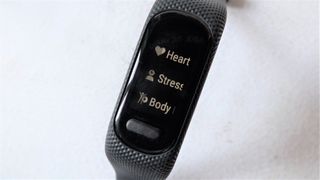
All-day stress monitoring is another helpful feature. Unlike the Fitbit Sense and Charge 5, which measure stress by checking for changes in the electrical conductivity of your stress, the Vivosmart 5 uses an algorithm called Firstbeat Analytics that's based on heart rate variability.
It can't always determine the difference between physical and emotional stress, but is suspended during tracked workouts, so should give you a good general idea of your mental state. If you are starting to feel the tension, the Vivosmart 5 (like all recent Garmin watches) can lead you through a very basic but effective square breathing exercise to lower your heart rate.
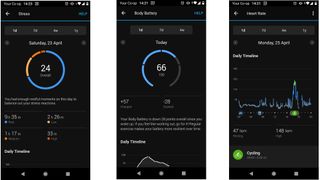
Workout tracking
- Can store 10 workout tracking modes
- No on-board GPS
- Responsive heart rate monitor
First, it's important to note that (like last year's Garmin Lily) the Garmin Vivosmart 5 doesn't have an on-board GPS module. Instead, it uses your phone's GPS chip to track your pace and route during outdoor activities, so if you choose to run or cycle without your handset, you'll only see basic workout stats at the end.
There's a huge range of different sports profiles to choose from, but the little Vivosmart 5 can only store 10 at a time, so you'll need to take a moment to set up your preferred activities in the Garmin Connect app before hitting the pavement, the pool, or the gym. Once that's done, just press the button on the tracker's face, select Activities, and you're ready to get started.

Automatic activity tracking also works well, and you can choose how long the Vivosmart 5 should wait before beginning to record.
However, bear in mind that the device won't connect to your phone's GPS unless you begin monitoring your workout manually. You'll still get distance measured using the device's accelerometer, but it won't be as accurate. In a measured 5km run, it was 150m short, and pace was quite dramatically off during an interval training session.
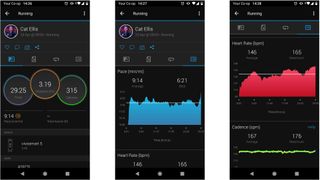
The Vivosmart 5 doesn't use the same heart rate monitor as recent watches like the Fenix 7 and Forerunner 55, but nevertheless it proved accurate and responsive in our interval training tests. You can also choose to broadcast your heart rate to a paired device via ANT+ compatible devices like treadmills (look for the ANT+ logo on your machine or check its manual to find out if yours will play along).
Once your workout is over, data is shared with the Garmin Connect app almost immediately provided your phone is within Bluetooth range. The watch can store data from seven timed activities, so don't worry if you can't sync it straight away.
Other tools
- No on-board music storage
- App and call notifications
The Vivosmart 5 has no on-board music storage, but that's to be expected for a device this small. You can, however, use it as a remote control for your phone's media player, meaning you don't have to dig your handset out of a pocket or armband mid-run when you want to switch tracks.
You can't use it to take calls either (you'll need the Garmin Venu 2 Plus for that). You will, however, be alerted to incoming calls and texts via customizable vibration on your wrist, and you can see small snippets of SMS, email, and app notifications by tapping them when they appear on the Vivosmart 5's display.
Another handy feature is the ability to find your phone using the Vivosmart 5 or vice versa – even if your phone is on silent. It's very loud, and very effective if you're disorganized.
Companion app
- Data syncs almost instantly
- Well organized and easy to understand
- Nothing behind a paywall
Like all Garmin fitness trackers and sports watches, the Vivosmart 5 syncs data with Garmin Connect. The app supports multiple devices, so if you own a chunky GPS watch and are thinking of picking up a Vivosmart to wear in between workouts, you'll have no trouble doing so – all your health and workout data will be collected together, regardless of which device was used to record it.
Garmin Connect is one of the best apps of its type, presenting a huge amount of data in a way that's clear and easy to understand. The app's homescreen is a dashboard containing stats for the current day such as heart rate, stress level, Body Battery (Garmin's name for your energy level), menstrual cycle, and recent workouts. You can add, remove, and rearrange these at will.
Tap any stat or dive into the app's menu, and you can drill down through increasingly detailed data on your health, fitness, and training.
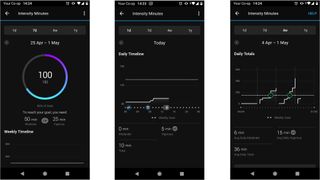
Everything in Garmin Connect is free, but if you're thinking of trading in your Fitbit, you should be aware that there are far fewer instructor-led workouts on offer here. If you're a runner or a cyclist then you'll appreciate the adaptive training plans that are designed to help you hit a particular goal (like completing a sportive or setting a new half marathon personal best), but you don't get the huge catalog of video tutorials you do with Fitbit Premium membership.
Which fitness tracker suits you best will depend on the type of experience you're looking for. If you're already happily settled into a workout routine, then the data-rich Vivosmart 5 may be the device for you, but if you want inspiration and more of a community experience then it's worth considering whether Fitbit membership will fit into your monthly budget.
Also consider
Garmin Forerunner 55
If you're getting serious about running, the Forerunner 55 is a superb entry-level GPS watch that'll help you manage your training load even if you don't have a set training plan to follow. You can now pick it up for only a little more than the Garmin Vivosmart 5, making it fantastic value.
Read our full Garmin Forerunner 55 review
Fitbit Luxe
If the Vivosmart 5 is too plain for your liking and you want something more attractive on your wrist, the Fitbit Luxe is a good alternative. Despite having a color AMOLED display, it has comparable battery life to the Vivosmart and covers all the fitness tracking essentials.
Read our full Fitbit Luxe review
Buy it if
You're a stats nerd
The Vivomove 5 is all about numbers, and it's remarkable how much data Garmin's interface designers have managed cram onto such a small display.
Your regular sports watch is too cumbersome
If you like your Garmin sports watch but find it too chunky for everyday wear, you can wear the Vivosmart 5 to collect health stats during the day and switch to your main watch for workouts. All your data from both devices will be pooled in the Garmin Connect app.
Don't buy it if
Looks are everything
The Vivosmart 5 is one of the more utilitarian fitness trackers we've tested in recent months. It's certainly not ugly, and the ability to switch bands in seconds is a nice bonus, but it's designed for function above all.
You're tough on your watches
The Vivosmart 5's display is topped with an acrylic lens rather than Gorilla Glass like most Garmin devices, which helps keep the weight down, but may mean it's more prone to scuffs and scratches. We had no trouble in our tests, but it's something to be aware of.
Cat is the editor of TechRadar's sister site Advnture. She’s a UK Athletics qualified run leader, and in her spare time enjoys nothing more than lacing up her shoes and hitting the roads and trails (the muddier, the better)


